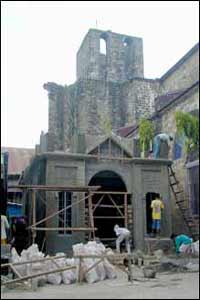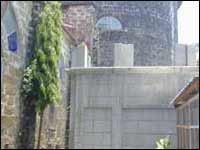Heritage
conservation is everyone's business
Posted 10:49pm (Mla time) April 03, 2005
By Augusto Villalon
Inquirer News Service
AMERICAN wood scientist Ron Anthony and heritage specialist Jim Joy were recent guests of the Heritage Conservation Society. The HCS partnered with the Dagupan Heritage Council and the Embassy of the United States in arranging three lectures by Anthony during his brief Manila visit.
After inspecting several heritage sites in Dagupan with city and HCS members, Anthony spoke on aspects of heritage conservation and pointed out the uniqueness of Dagupan heritage during a meeting organized by the Dagupan Heritage Council with Mayor Benjamin Lim.
As one of the speakers at the UP Art Studies Class 281 forum, "Securing Our Church Cultural Heritage," Anthony underscored the multidisciplinary nature of heritage conservation, where a team including architects, engineers, technicians, historians and other professionals is required to develop a conservation methodology before carrying a project through.
Textbook solutions, warned Anthony, could be more damaging to heritage structures. He pointed out the need for architects, engineers and other construction professionals to think creatively.
Replacing entire roof systems of antique wooden trusses with steel instead of repairing only damaged wooden members can be costlier and equally damaging to old structural systems not designed to take the stresses of steel framing. To avoid similar conservation blunders, consultation with building owners and other specialists is the key to protecting our heritage effectively.
Anthony's second presentation was to a large audience in the elegantly restored ballroom of the US embassy in Manila. He spoke of conservation rationale, of how old buildings and neighborhoods could be "read" to actually tell the story of the people, and of how fleeting heritage was. Once heritage vanishes, it is gone forever.
Heritage mission
Sponsoring conservation experts like Ron Anthony and Jim Joy to share their expertise with local heritage practitioners is one of the many Heritage Conservation Society's activities.
The organization continues with its mission of protecting the Philippine built heritage from vanishing, refocusing its advocacy within the past two years toward local governments and professional organizations.
HCS provides consultancy services to undertake heritage projects. It has restored heritage schoolhouses in Bacolod and Baguio. It is in restoring Pampanga High School in San Fernando, Legarda Elementary School in Manila, and Teachers Camp in Baguio.
HCS members visit local government authorities, making them aware of their unnoticed heritage and the benefits of conservation, establishing close contact with the governments of Quezon province, the cities of San Fernando (Pampanga), Baguio, Dagupan, Iloilo City, and the town of Carcar (Cebu).
The organization assists local governments in identifying and documenting their heritage structures, designating heritage zones and legislating protective measures to preserve structures within the zones.
HCS involvement with the Philippine Institute of Environmental Planners has brought about a greater awareness among environmental planners that heritage protection must be enforced in the national and local levels. PIEP and HCS members join to conduct regular awareness training with local government units.
The HCS Youth Sector is the most active group in the organization. Students are always involved in all of the organization's projects. Under supervision of HCS members, students participate in the Heritage Schoolhouse Restoration Program.
For each school, local architecture and engineering students inspect, photograph, measure and produce plans of the existing structures.
History students do archival research on the building, interview residents, and prepare the historical background necessary for conservation.
Other student groups have joined to contribute their specialties to each project.
In the past two years, the Youth Sector organized heritage fora for students at University of Santo Tomas, Far Eastern University, La Consolacion College (Bacolod), Ateneo de Manila, and Teachers Camp (Baguio).
Activities have been constant. Funds for HCS projects trickle in from membership dues, public fund-raising activities, and partially generated from fees collected from consultancy services.
Heritage watch: Silliman University
Plans are afoot for the construction of a Jollibee drive-through store within the landmark area of Silliman University in Dumaguete (Negros Oriental), declared a National Landmark by the National Historical Institute in 2002.
The boundaries of the landmark area are Silliman Avenue, the National Road, Venancio Aldecoa Sr. Road, Hibbard Avenue, Katanda Street, Lo-oc Road, Rizal Avenue, and the Dumaguete Bay waterfront.
Within the landmark area, no new structure can be constructed without NHI approval.
This issue is an example of a common misconception that historic sites stand alone without any relationship to their surroundings.
Setting is important. Silliman University has so much history and charm which must be preserved. A heritage building diminishes in value if a new structure encroaches on it. Therefore proper historic site conservation includes preservation of the setting around it.
Usually a designated buffer zone surrounds a historic structure to protect it from vibratory damage from new constructions, from being overpowered by a newly built neighboring skyscraper, or from being blocked from public view.
Visual considerations are important, too. Vistas are to be maintained and sight lines to the heritage structure should remain uncluttered.
A suggestion would be for Silliman University, Jollibee, the NHI, and qualified conservation practitioners to get together for a dialogue on whether the store should actually be at that location, or how such a store might be incorporated on the Silliman University campus in the same manner that fast-food stores are made to fit into historic districts of so many cities in the world.
Erratum: The correct name is Kawasan Falls in Badian (Cebu), not Kayasan, as I mistakenly called it in last week's column. I cannot apologize enough for the embarrassment I caused to the Kawasan Falls community.
E-mail the author at afvillalon@hotmail.com
©2005 www.inq7.net all rights reserved

